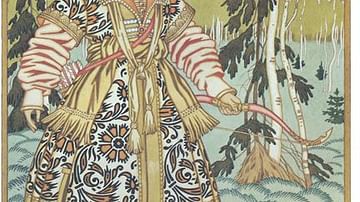Review

| Rating: | |
|---|---|
| Title: | The Slavic Myths |
| Author: | Noah Charney & Svetlana Slapšak |
| Audience: | General Public |
| Difficulty: | Easy |
| Publisher: | Thames & Hudson |
| Published: | 2023 |
| Pages: | 256 |
'The Slavic Myths' by Noah Charney and Svetlana Slapšak is a book comprising seven new retellings of Slavic myths each accompanied by an academic analysis of the myth and its history. This book is an accessible introduction to Slavic mythology and connects tales of both popular and lesser-known creatures today, such as vampires, werewolves, Perun, Vasilissa, and Baba Yaga, to their foundations within Slavic mythology.
The Slavic Myths, by the historian Noah Charney and the anthropologist and historian Svetlana Slapšak, is a wonderfully written and beautifully illustrated book delving into various Slavic myths, gods, and supernatural figures as well as the histories behind them. The Slavic Myths contains eight chapters and The Slav Epic, a cycle of 20 canvases by the Czech artist Alphonse Mucha depicting Czech and Slavic mythologies. Each chapter includes a new retelling of a myth, reimagined by the two authors, followed by a section on the history of the myth and numerous important features within it. This is not a compilation of everything we know about Slavic mythology. Instead, the seven hand-picked stories accompanied by accessible academic analysis allow readers, whether they are well-versed in Slavic myth or brand new to the corpus of tales, to enjoy the stories and, if they wish, develop their understanding of the myths and history further. Readers of The Slavic Myths can read the book from cover to cover, or they can jump in and just read a chapter at a time; similarly, they can stick to the compelling reimaginings of the chosen myth or dive into the historical analysis of each section. Either way, with the book being a combination of retelling and non-fiction, it can be enjoyed by all.
Slavic mythology is not as clear-cut as their Greek or Roman counterparts. There is no equating the Greek king of the gods Zeus with any equivalent figures in Slavic traditions. Charney and Slapšak had a huge task ahead of them in this book, especially with Slavic mythology originating first as an oral tradition, only being written down in the 19th century. These 19th-century tales, however, were written with specific goals of lending authority and adding history to new cities or overlying Christian morals and motifs. As mentioned in the book, a 9th-century Slav might not recognize their myths today in the forms they now take. Still, this book has essentially added a new layer to this rich and ever-developing corpus of stories, deities, and creatures.
This book is a wonderful introduction to Slavic mythology. Before picking it up, I had a vague familiarity with Baba Yaga, her house with chicken legs, and the firebirds. Beyond that, I was completely unfamiliar with the Slavic pantheon or the history behind these myths and tales. What captured my attention, beyond the stunning woodcut imagery throughout the book, was the collection of surprising historical details that few people pay attention to. For example, Slavic traditions tell that the vampire and the werewolf are intrinsically linked creatures! I learned so much about the history and development of Slavic myths, and particularly enjoyed the analysis of folklore vs fairytales vs mythology, and the creation of myths with ‘mythurgy.’ I was intrigued to find parallels with classical Greek tales such as Jason and the Argonauts, to find hints of well-known fairytales such as Cinderella and her horrible stepmother and stepsisters, and aspects of Ovid’s Metamorphosis with the trials Venus has Psyche complete, all solidly within the world of Slavic mythology. I didn’t know that throwing a coin over my shoulder into a fountain or body of water originated as a Slavic ritual in fear of the dead.
I could not recommend this book enough for those looking to dip their toe into some new myths, or for those who are looking to read a new version of their old favorite Slavic myth.
This review was originally posted on Kell-Read.
About the Reviewer
Cite This Work
APA Style
Macquire, K. (2023, December 15). The Slavic Myths. World History Encyclopedia. Retrieved from https://www.worldhistory.org/review/389/the-slavic-myths/
Chicago Style
Macquire, Kelly. "The Slavic Myths." World History Encyclopedia. Last modified December 15, 2023. https://www.worldhistory.org/review/389/the-slavic-myths/.
MLA Style
Macquire, Kelly. "The Slavic Myths." World History Encyclopedia. World History Encyclopedia, 15 Dec 2023, https://www.worldhistory.org/review/389/the-slavic-myths/. Web. 21 Apr 2025.




